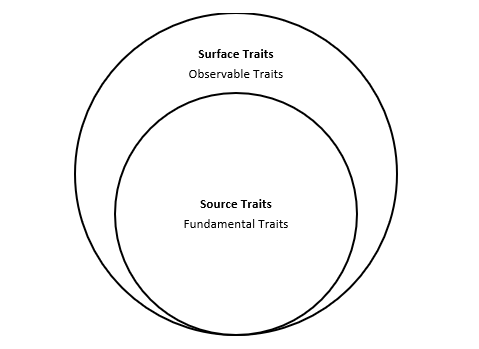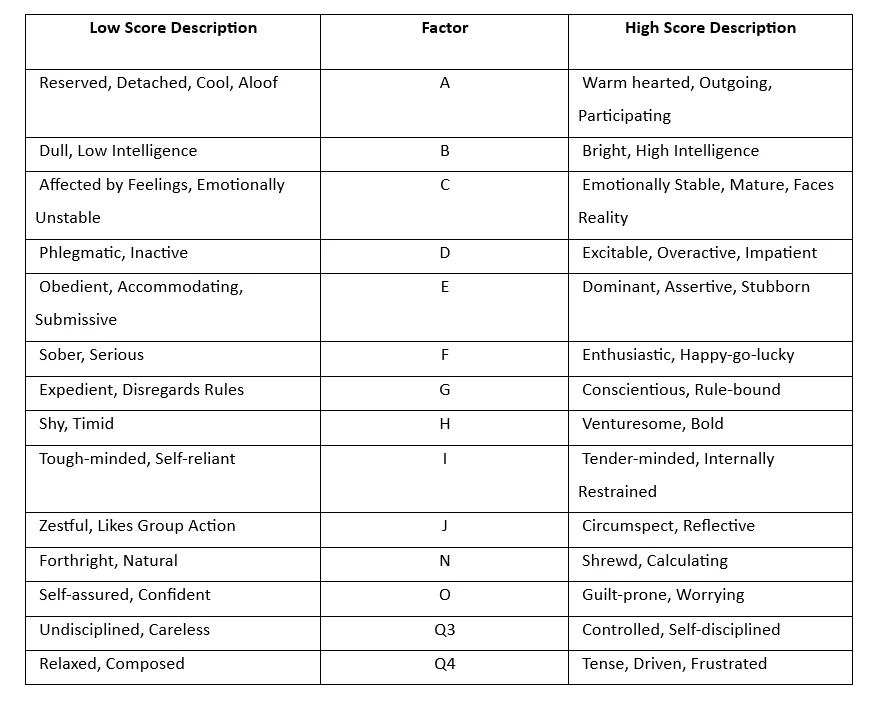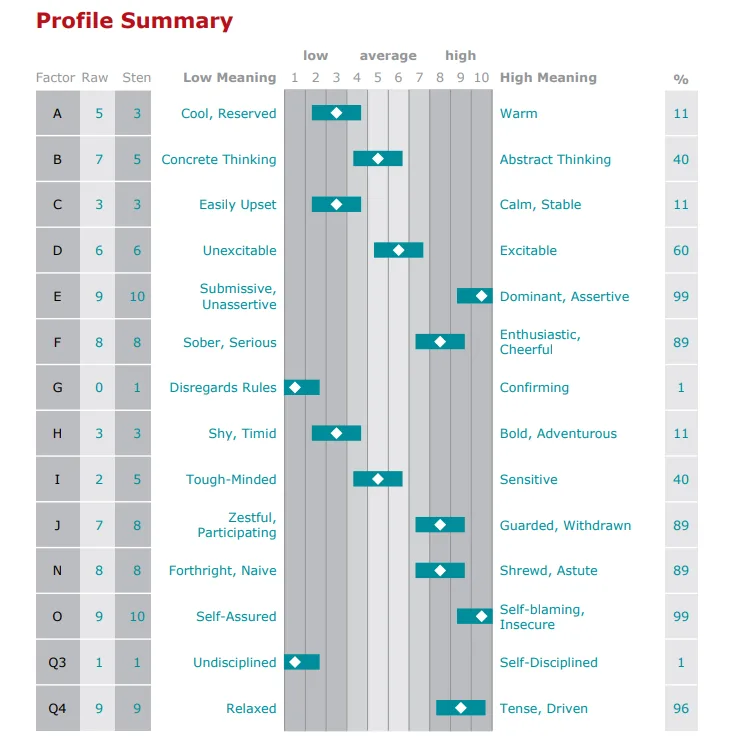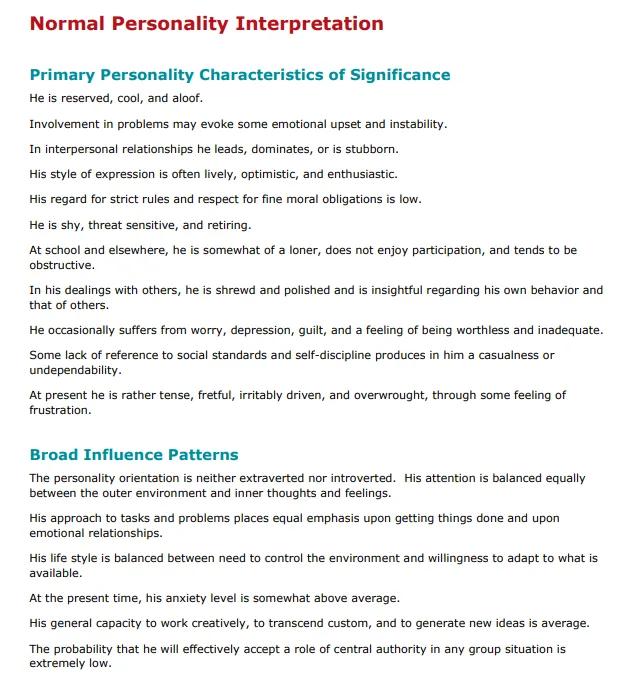Introduction
In the educational setting, psychological assessments are essential tools for evaluating various aspects of a child’s development. These assessments provide valuable insights into the child’s personality, academic performance, and social adjustment, helping educators and psychologists understand individual differences and needs.
One such assessment is the Children’s Personality Questionnaire (CPQ), a specialized tool designed to measure the personal, social, and academic attributes of children that significantly impact their performance both in school and in broader life contexts. Developed by Rutherford Burchard Porter and Raymond B. Cattell in 1956, the CPQ offers a structured and reliable method for identifying key personality traits in children aged 8 to 12. This age group is particularly critical for personality development, as children begin to form their self-concept and social identities during these formative years.
By assessing 14 distinct personality dimensions, the CPQ aids in identifying strengths and weaknesses in children’s personalities. This information is invaluable for educators when tailoring instructional approaches and interventions to meet the diverse needs of their students. Additionally, understanding a child’s personality can enhance communication and foster positive relationships between teachers and students, ultimately promoting a supportive and effective learning environment. Thus, psychological assessments like the CPQ are integral to fostering holistic child development in educational settings.
Read More- Personality
What is Personality?
Personality refers to the unique and consistent patterns of thoughts, feelings, and behaviours that define an individual. It encompasses the characteristic ways in which people interact with the world, respond to situations, and relate to others. Personality is shaped by a combination of biological, psychological, and environmental factors, making it a complex and multi-dimensional concept.
Cattell (1950) described personality as “that which permits a prediction of what a person will do in a given situation.” His approach focuses on understanding personality traits that are stable over time and measurable through factor analysis.
Characteristics of Personality
- Consistency- Personality is generally stable over time and across different situations. While behaviour may change in response to specific circumstances, underlying personality traits tend to remain consistent.
- Individual Differences- Personality reflects the unique variations between individuals. While people may share certain traits, the combination and intensity of these traits differ from person to person, which explains why everyone behaves in distinct ways, even in similar situations.
- Personality Traits- Traits are enduring characteristics that influence behaviour. Commonly discussed traits include- extraversion, agreeableness, openness to experience, etc.
- Influence on Behaviour- Personality traits strongly influence how individuals react to situations and their behavioural tendencies.
- Hereditary and Environmental Influences- Personality is shaped by both biological (genetic) factors and environmental influences. Temperament, which is closely linked to genetics, forms the basis of personality.
- Influence on Interpersonal Relationships- Personality significantly affects how individuals relate to others. Traits like empathy, agreeableness, and extroversion can help form positive social relationships, while traits like dominance or aggression might lead to conflicts or difficulties in social settings.
- Predictive of Life Outcomes- Personality traits can be predictive of various life outcomes, such as career success, relationship satisfaction, and even physical health(Roberts et al, 2007).
- Conscious and Unconscious Elements- Personality consists of both conscious elements (the parts of ourselves we are aware of and can control) and unconscious influences (thoughts and impulses that affect behaviour without our conscious awareness, as emphasized by Freudian theory).
Description of the Children’s Personality Questionnaire (CPQ)
The Children’s Personality Questionnaire (CPQ) is a self-report personality test designed to assess the personality traits of children between the ages of 8 and 12. It is a multifaceted tool, developed to measure 14 distinct personality dimensions in children, offering insights into how these traits influence both academic performance and social adjustment, inside and outside the classroom.
Origins of Children’s Personality Questionnaire (CPQ)
The CPQ was created by Rutherford Burchard Porter and Raymond B. Cattell (known for his work on the 16 Personality Factor (16PF) model in adults).
Cattell’s work in personality psychology focused on identifying key traits, referred to as source traits, which are considered the building blocks of an individual’s personality. Surface traits are formed from a combination of source traits. These traits were determined through factor analysis, a statistical method used to identify patterns or clusters of related variables.

Cattell’s Theory of Personality
Cattell and Porter extended this model to children, creating the CPQ as a reliable instrument to evaluate these personality traits during childhood, a period marked by rapid developmental changes.
Read More- Cattell’s Theory of Personality
Structure of CPQ
The CPQ consists of four forms (A, B, C, and D), with each form containing 140 items. These items are designed to be as neutral as possible, reducing bias related to social desirability.
Each form is broken into two parts, with 70 items in each part, offering flexibility in administration, especially for younger children who may find lengthy assessments challenging. In total, each form contains 10 items per factor, ensuring that all 14 personality dimensions are adequately represented.
The test uses a forced-choice format, where children respond with either a “yes” or “no” answer, except for items assessing Factor B (intelligence), which are scored differently.
The language and content are intentionally kept simple, requiring only a normal reading vocabulary expected of an average 8-year-old child. The lack of a time limit for the test is beneficial, as it ensures that children do not feel pressured to complete the test quickly, which can result in more thoughtful and accurate responses.
The 14 Source Traits
The CPQ is designed to assess 14 personality dimensions, also known as source traits, which Cattell identified through his factor analysis research. These traits are considered fundamental aspects of a child’s personality, influencing their emotional, social, and cognitive functioning. Below is a breakdown of the 14 source traits measured by the CPQ, along with a brief description of low and high scores for each trait-

14 Source Traits- Children’s Personality Questionnaire (CPQ)
Each of these factors provides a comprehensive picture of a child’s personality, giving educators, psychologists, and parents an understanding of how these traits might influence a child’s behaviour and success in school and social situations.
For example- children scoring high in Factor E (Dominance) may be assertive and competitive in group activities, while those with high scores in Factor H (Venturesome) are likely to be socially bold and uninhibited.
Psychometric Properties of Children’s Personality Questionnaire (CPQ)
To ensure that the CPQ provides reliable and valid measures of personality traits, its psychometric properties have been rigorously evaluated. Psychometrics refers to the science of measuring mental capacities and processes, such as personality traits, using reliable and valid tests.
Reliability of CPQ
Reliability refers to the consistency or stability of the test over time. The CPQ has demonstrated test-retest reliability, with correlations ranging from 0.28 to 0.87 after a one-week interval. This range indicates that while some traits are measured consistently, others may show variability over short periods, potentially due to the child’s changing mood or circumstances during testing.
Internal consistency, measured using the Kuder-Richardson Formula 21, ranges from 0.32 to 0.86, with most factors clustering in the 0.70s. This suggests that, for the most part, the items within each factor are measuring the same underlying trait.
Validity of CPQ
Validity refers to the degree to which a test measures what it purports to measure. The CPQ has demonstrated construct validity, which indicates that the test accurately reflects the hypothesized structure of personality traits in children.
However, some criticisms have been raised regarding the need for further re-examination of the test’s validity, as certain factors did not correlate as strongly as expected with the traits they were designed to measure. This may be due in part to the complexities of assessing personality in young children, who may not always have a clear understanding of their own behaviours and motivations.
Scoring and Norms of Children’s Personality Questionnaire (CPQ)
The CPQ offers a clear and structured approach to scoring, with separate stencils provided to score the answer sheets. Two stencils are required to obtain the 14 raw scores from each form, and these raw scores are then converted into standard scores using one of three methods-
- S-stens (Standard Deviation Stens)- These are based on the distribution of scores within a given population, using standard deviations as a reference.
- N-stens (Normalized Stens)- This method adjusts the distribution of scores to fit a normal curve, ensuring that the results are evenly distributed across the population.
- Percentile Ranks- This method compares a child’s score to a normative sample, indicating the percentage of children in the sample who scored lower.

Children’s Personality Questionnaire (CPQ) Summary Page

Interpretation of CPQ
Separate norms tables are provided for boys and girls, acknowledging the clear-cut personality differences often observed between genders. The availability of both combined and gender-specific norms ensures that the CPQ can be tailored to the specific population being tested, enhancing the accuracy and relevance of the results.
Applications and Uses of Children’s Personality Questionnaire (CPQ)
The CPQ is a versatile tool, with a wide range of applications including-
- Educational Guidance- One of the primary applications of the CPQ is to assist educators in identifying students who may require additional emotional or behavioural support. By recognizing personality traits such as guilt proneness (Factor O) or emotional instability (Factor C), teachers can tailor their approach to help students overcome emotional conflicts that may be impacting their academic performance. This early recognition allows for intervention before these issues become ingrained, reducing the likelihood of long-term behavioural problems.
- Screening and Intervention- The CPQ can be used as a screening tool to identify children who may need further psychological evaluation or intervention. For example, children with high scores in Factor Q4 (Tension) may be struggling with anxiety or stress, while those with high scores in Factor Q3 (Self-Discipline) may exhibit compulsive or overly controlled behaviour. By identifying these traits early, interventions can be implemented to address emotional conflicts before they become more severe.
- Academic and Vocational Guidance- The CPQ can also aid in helping students make informed decisions about their future educational and vocational goals. By assessing traits such as intelligence (Factor B) and conscientiousness (Factor G), educators can predict future academic achievement and help students choose courses or career paths that align with their personality strengths.
- Longitudinal Studies- The CPQ is useful for tracking the progressive development of personality over time. By administering the test at multiple points during a child’s education, educators and psychologists can observe changes in traits such as self-control, emotional maturity, and social learning.
- Clinical and Legal Settings- The CPQ has applications in clinical practice, particularly for psychologists working with children experiencing behavioural disorders or delinquency. It can provide a diagnostic tool for evaluating personality traits that may contribute to problematic behaviour, allowing for targeted therapeutic interventions
Strengths of CPQ
Some strengths of CPQ include-
- Comprehensive Assessment- The CPQ measures 14 distinct dimensions of personality, providing a broad understanding of a child’s personality profile. This comprehensive approach helps educators and psychologists assess various traits that can impact behaviour and development.
- Age Appropriateness- Designed specifically for children aged 8 to 12 years, the CPQ uses a vocabulary and format suitable for this age group, making it accessible and easy to understand.
- Clinical and Educational Applications- The CPQ is useful in both educational and clinical settings. It can help identify children who may need additional support, guide educational decisions, and inform therapeutic interventions.
- Standardization- The CPQ is standardized, meaning it has been tested on a large and representative sample of children. This allows for comparisons between individual scores and normative data, providing valuable insights into a child’s personality relative to peers.
- Diagnostic Utility- The test can aid in diagnosing emotional conflicts and behavioural disorders, allowing for earlier intervention and support. This can prevent the development of more serious issues later in life.
- Multiple Forms- With four different forms (A, B, C, D), the CPQ offers flexibility in administration and allows for repeated testing to track changes in personality over time.
Critical Analysis of the CPQ
While the CPQ has been widely used and praised for its comprehensive assessment of children’s personalities but there are several criticisms and areas for improvement that must be considered.
- Lack of Information- One major concern is the lack of detailed information about the test’s standardization sample, making it difficult to evaluate the test’s generalizability to diverse populations. Additionally, the handbook does not specify when the data was collected, raising questions about the relevance of the norms to contemporary children.
- Interpretation of test scores- The CPQ provides limited guidance for interpreting profile patterns, making it challenging for test administrators to draw meaningful conclusions from the results. Furthermore, the scoring and administration process can be time-consuming, particularly when multiple forms are administered in separate sessions.
- Validity of the CPQ- the validity of the test has been questioned in recent years. Some reviewers have called for a re-examination of the test’s validity, as several factors were found not to correlate as strongly as expected with the traits they were designed to measure. This suggests that the CPQ may need revision to reflect advancements in personality psychology and developmental research.
Conclusion
The Children’s Personality Questionnaire (CPQ) remains a valuable tool for assessing the personality traits of children, with broad applications in both educational and clinical settings. It offers a structured method for identifying key personality traits that influence children’s academic and social development. However, despite its widespread use, the CPQ requires further refinement and revision to address concerns about its validity, standardization, and interpretation. As psychological research continues to evolve, it is essential that tools like the CPQ be updated to reflect new understandings of personality development in children. This will ensure that educators and psychologists can continue to provide accurate, meaningful assessments that contribute to the well-being and success of children.
References
Cattell, R. B. (1950). Personality: A systematic theoretical and factual study. McGraw-Hill.
Cattell, R. B. (1956). The Children’s Personality Questionnaire (CPQ). Champaign, IL: Institute for Personality and Ability Testing.
Cattell, R. B., & Porter, R. B. (1956). Development of the Children’s Personality Questionnaire. Journal of Personality Assessment, 20(4), 432-445. https://doi.org/10.1080/00223891.1956.9919286
Cooper, C. (2018). Psychological testing and assessment. Oxford University Press.
Kaplan, R. M., & Saccuzzo, D. P. (2017). Psychological testing: Principles, applications, and issues (9th ed.). Cengage Learning.
Naglieri, J. A., & LeBuffe, P. A. (2005). Measuring resilience in children: From theory to practice. In S. Goldstein & R. Brooks (Eds.), Handbook of resilience in children (pp. 107-121). Springer.
Pervin, L. A., Cervone, D., & John, O. P. (2005). Personality: Theory and research (9th ed.). Wiley.
Russell, M. (2005). Critique and revision of the CPQ: Addressing contemporary challenges in children’s personality assessment. Journal of Educational Psychology, 97(3), 512-528. https://doi.org/10.1037/0022-0663.97.3.512
Roberts, B. W., Kuncel, N. R., Shiner, R., Caspi, A., & Goldberg, L. R. (2007). The power of personality: The comparative validity of personality traits, socioeconomic status, and cognitive ability for predicting important life outcomes. Perspectives on Psychological Science, 2(4), 313–345. https://doi.org/10.1111/j.1745-6916.2007.00047.x
Schuerger, J. M. (1992). Assessment of children’s personality using the CPQ: Advances and limitations. Academic Press.
Spielberger, C. D. (Ed.). (2004). Encyclopedia of applied psychology. Elsevier Academic Press.
Sternberg, R. J., & Grigorenko, E. L. (2004). Dynamic testing: The nature and measurement of learning potential. Cambridge University Press.
Subscribe to Careershodh
Get the latest updates and insights.
Join 18,509 other subscribers!
Niwlikar, B. A. (2019, April 13). Children’s Personality Questionnaire (CPQ)- To Discover 14 Insightful Personality Traits. Careershodh. https://www.careershodh.com/childrens-personality-questionnaire/

Hi there mates, how is the whole thing, and what you would like
to say regarding this article, in my view its actually awesome for me.
How to take test
Visit the nearest psychologist for the test.
Can someone tell me who publishes the CPQ and how I can acquire a kit?
It is with us. Please send Your Requirements on careershodh@gmail.com
Can this test be conducted on Indian children? Has it been tested on Indian population earlier??
Yes.
I NEED THE CPQ MANUAL.
HOW TO GET IT
nkouakouoscar@yahoo.com
Mail us your requirement on careershodh@gmail.com
How can I get a copy of forms A and B?
I would like to speak with someone about the CPQ. I am having an event in June, 2024 and would like to use this document.
you can call on the given number. Email us on careershodh@gmail.com